BestReviews is reader-supported and may earn an affiliate commission. Details
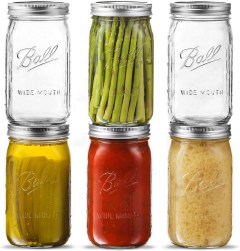
Large canning jars made by a trusted brand that's been producing quality canning products for more than 100 years.
Classic glass jars hold 32 ounces each. Wide openings can accommodate large pieces of food. A popular choice for a wide range of canning needs. Pack includes 6 jars with lids and bands.
Some reports of orders that contained jars that weren't the right size. Rare reports of flaws in the glass.
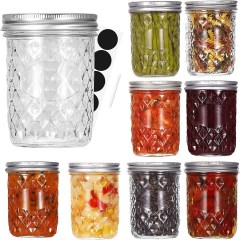
Attractive midsize canning jars that aren't the most versatile, but present preserved foods in style.
Pretty jars with diamond patterns in the glass. Pack of 8 jars each with a 16-ounce capacity. Set includes lids, bands, and labels. Available at a decent price.
Not designed for extremely hot temperatures, so check out others on our list if you plan to pressure can or use a hot water bath.
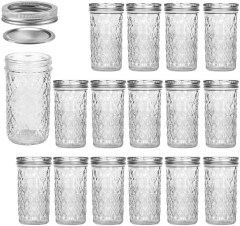
Canning jars that stand out when it comes to appearance but also come with some durability issues.
Tall jars with an etched diamond pattern that looks great when filled with food. A good choice for fermenting and pickling. Pack includes 15 12-ounce jars with lids and bands.
Not suitable for pressure canning. Glass isn't as durable as some competing brands and may crack fairly easily.
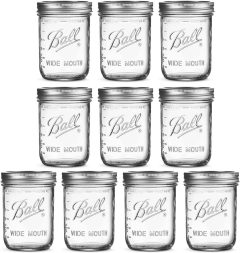
A large set of easy-to-use jars from a trusted brand with a uniquely designed lid.
Ten glass jars with metal lids. Each jar holds 16 ounces and is microwavable and dishwasher safe. The 2-part lid has a cover with lines for writing the date and a twist-on ring with a rubber seal. Made in the USA.
Pricier than some other options.
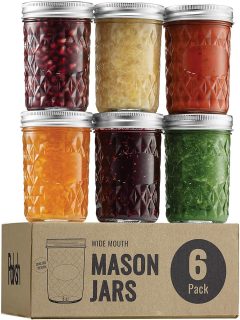
An affordable set of canning jars with a stylish textured design that offers a flat area for labeling.
Includes 6 8-ounce glass jars with lids, 6 black labels, and 1 marker. The 2-part lid consists of a cover with a button for testing food quality and an outer rust-proof ring. Has a standard-sized opening.
Smaller than some other options.

We recommend these products based on an intensive research process that's designed to cut through the noise and find the top products in this space. Guided by experts, we spend hours looking into the factors that matter, to bring you these selections.

If you have a garden you’re proud of, you probably wind up with more produce than you can handle from time to time. Even after giving some to friends and family, you may waste those prize tomatoes and berries — unless you start canning your extra fruits and veggies. But you won’t get very far in the canning process if you don’t have the right canning jars.
The jars must be heat-resistant and able to withstand high pressure without breaking. They also need to create an airtight seal with their lids to preserve the food inside. You can reuse canning jars, but it helps to build a large collection so you have enough no matter how much food you need to preserve.
If you’re looking for high-quality canning jars, you should start by identifying the type and size of jars that will work best for your food, determining what to look for in the jars’ material, and deciding on other features that can come in handy. This shopping guide and its product recommendations will give you all the information to choose the best canning jars for your projects.

Before you shop for canning jars, it helps to understand the canning process. You can use one of two canning methods: water-bath canning or pressure canning.
Water-bath canning is the most popular method. You fill clean, sanitized jars with the food you want to preserve, place the lids and threaded rings on the jars, and then place them in a pot of boiling water for a specific period based on the type of food. When you take the jars out of the hot water, they release the heat, which removes any remaining air from inside. As the air leaves the jars, it locks the lids in place and creates an airtight seal for the jars.
Pressure canning requires a pressure canner, which consists of a pot with a rack, a vented lid, a pressure gauge, and a safety valve. While water-bath canning heats the food to 212°F, pressure canning can heat them to 240°F to 250°F.
A water-bath canner works best for highly acidic foods such as tomatoes, jams, jellies, and pickles, because a temperature of 212°F is enough to kill any bacteria or other microorganisms in your food. On the other hand, pressure canners are needed for low acid foods, such as non-pickled vegetables, soups, and stocks, because they require higher temperatures to kill bacteria.
Canning jars, also known as mason jars, are available in regular-mouth and wide-mouth styles.
Canning jars should be made of thick, tempered glass. This type of glass won’t break when exposed to the high temperatures and pressure that canning requires. Also make sure that any jars you consider are food-grade so they don’t contain any lead or other toxins that could leach into your food.
If you’re following a canning recipe, stick to the jar size in the instructions. It ensures you’ll get the processing time right and wind up with the best results.
You can find jars in various sizes — there’s an option for any food or recipe you’re canning. If you’re following a recipe, it usually provides a recommended size. Using the right size jar is essential because the size affects how long you need to heat the food for proper preservation.
The most common jar sizes for regular-mouth and wide-mouth styles are:
Regular-mouth jars are often available in four-ounce and 12-ounce sizes, which you can use for jellies, jams, preserves, marmalades, and small fruits and vegetables. Wide-mouth jars may also come in a 64-ounce size suitable for large-batch canning of fruits and veggies and juices.
While you can purchase individual jars, most are sold in sets. Some sets contain as few as three jars, while others include as many as 30. While larger sets cost more, the price per jar is generally lower. If you know you’re going to do a lot of canning, you’re better off buying a larger set to get the best value.
When you can food, it’s to preserve it and extend its shelf life, meaning you’ll probably have many jars you need to store in your pantry or cabinet. Some canning jars are designed for stacking, which allows you to place the jars on top of one another and maximize space on your shelves.
Nearly all canning jars come with lids and ring bands to secure them for canning. However, some jars include other accessories that can help with the canning process. For example, you can find jars that include waterproof labels you stick on the jars after canning to indicate what they contain and the date canned. Some jar sets also include a pen or marker to help with labeling.

For water-bath canning, you need a good-sized canning pot to get the job done. You can find stainless steel or porcelain pots. Those designed specifically for canning often include a rack to set your jars on.
If you prefer pressure canning, you need a pressure canner to safely and effectively preserve your food. Some models have a dial gauge that displays the pressure reading, in which case you must monitor it carefully. Other canners use a weighted gauge that lets you turn the canner on and walk away without having to watch it.
A canning jar lifter, which resembles a pair of tongs, makes it much easier to safely remove your jars from the canning pot or pressure canner when they’re ready. You can also use it when you’re sterilizing jars before you start canning.
The most affordable canning jars are sets of small jars that hold eight ounces or less. Most of these sets contain between three and 12 jars and cost $12 to $22.
Mid-range canning jars are sets of midsize jars that hold eight to 16 ounces. Most of these sets contain four to 12 jars and cost $22 to $35.
The most expensive canning jars are midsize to large jars that hold 12 to 32 ounces. Most of these sets contain between six and 30 jars and cost $30 to $50.
If you have extra jars you aren’t using for canning, they can also make excellent storage containers in your pantry for items such as flour, sugar, or rolled oats.

A. Start by washing the jars with hot water and dish detergent. Next, set the jars right-side up on a rack inside a water bath canner or another large pot. Add enough water to fill the container up to one inch above the top of the jars. Then, boil the jars in the water for 10 minutes to get rid of any contaminants.
When the jars are sterilized, you don’t need to dry them. Instead, leave them in the pot until you’re ready to fill them, and just dump out the water when you’re ready. Make sure you place them on a towel to fill them; they may shatter if you set them out on a countertop or table.
A. While you may be tempted to rinse out mayonnaise, pickle, or pasta sauce jars for canning, they may not be made of tempered glass. This means these jars can’t withstand the heat necessary for the canning process and may break. They may not be able to form an airtight seal, either. It’s best to stick to jars meant specifically for canning.
A. You can use canning jars multiple times as long as they’re not cracked or chipped. However, you shouldn’t reuse metal canning lids. They’re meant for one-time use and may not seal fully if you use them again, putting your food at risk for contamination.
Get emails you’ll love.
Learn about the products you’re wondering if you should buy and get advice on using your latest purchases.
